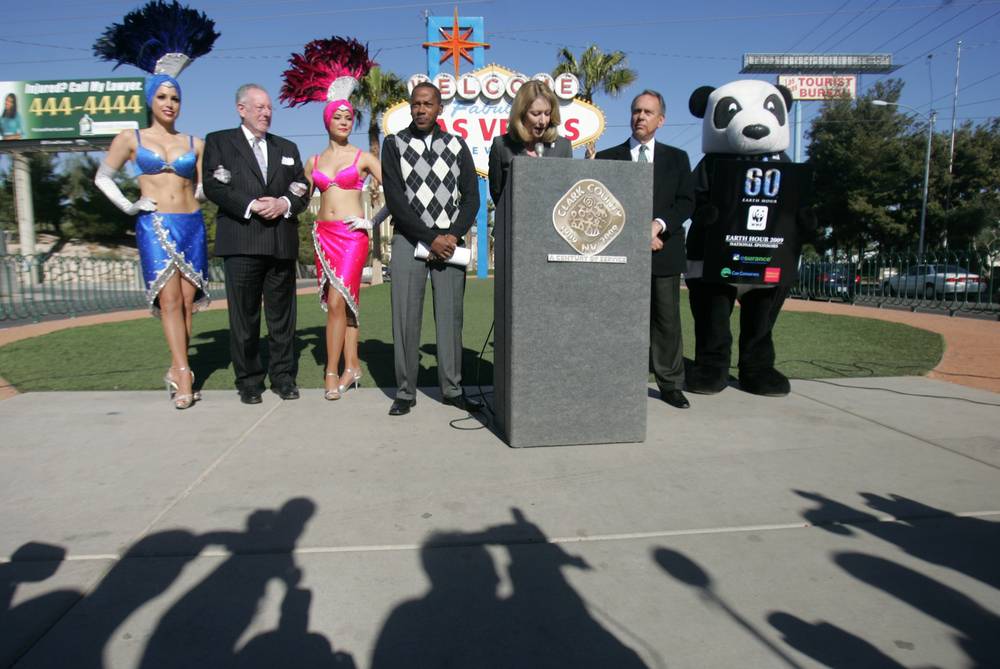Welcome to fabulous, energy-devouring Las Vegas, Mother Earth. We’re standing under that iconic sign—the freshly paved parking lot looks great—waiting for the mayor of Las Vegas to talk about climate change this morning. Hundreds of cars hurtle past, spritzing us with exhaust. A Southwest jet thunders in toward McCarran so close you want to duck. There’s a man in a panda costume here. And showgirls for each of the mayor’s elbows.
I count 12 electric lines stretched across the Las Vegas Strip here, a few blocks south of the insane blast of lights that makes the city famous—the lights that, we’re about to find out, will be dimmed for an hour in late March to call attention to global warming: the idea that wasting energy and using dirty fuels screws with the planet’s climate, kills animal and plant species and threatens human existence. An empty tour bus idles next to us while its passengers get shots of the fabulous sign.
The mayor, routinely drunk with the joy of marketing the city of excess, strolls up between the feather- and rhinestone-bedecked women and gives a bubbly spiel about conservation. Vegas has been chosen by the World Wildlife Fund (thus, the panda) to be a save-the-Earth flagship.
“The neon will go dark. I’m very, very proud that we are going to be a symbol of making sure that the city understands ... climate control,” says Oscar, the symbol of Vegas, next to the panda man, the symbol of an endangered species. “Las Vegas will actually be at the forefront of this noble effort.”
Last year, 50 million people in 370 cities worldwide switched off their lights for Earth Hour; this year World Wildlife is hoping that 1 billion people will turn off their lights to show that they care enough about climate change to bear the dim. It’s layers upon layers of marketing and symbolic gestures, but sometimes, it takes a symbolic victory to get heavy work started.
Across town the next day, a panel of buttoned-up renewable-energy experts sits in front of rows of similarly suited men and women in a UNLV conference room, focusing, again, on weaning us from fossil fuels—and how that can redefine Nevada. They’re all looking at a screen that bears the image of Thomas Edison. Below Edison is his quote:
More
- Beyond the Weekly
- Las Vegas to dim neon glow for climate change (Las Vegas Sun, 1/28/09)
“I’d put my money on the sun and solar energy. What a source of power! I hope we don’t have to wait until oil and coal run out before we tackle that.”
Rose McKinney-James, principal of Energy Works Consulting and a former director of intergovernmental affairs for the city of Las Vegas, is showcasing Edison’s comment in the city of lights with the hope of plucking us from a recession, saving Nevada from the endangered-species list.
“I’ve been waiting for two decades for the development of renewable energy in the state of Nevada,” she tells the crowd, most of whom have spent the morning dwelling on the sorry state of the economy at Preview 2009, an annual Chamber of Commerce event.
“It requires an investment up front, but the fuel is free,” McKinney-James says. “The key in my view is a willingness to work collaboratively, and I think we finally are here to do just that.”
Next to her on the panel are the CEOs of NV Energy and Southwest Gas, along with Jon Wellinghoff of the Federal Energy Regulatory Commission—no pandas or showgirls, but a show of enthusiasm about a new approach to energy nonetheless: “I think we’re going to get there soon,” Wellinghoff echoes.
News of the burgeoning age of renewable energy is unavoidable: State Democrats are pushing for green jobs—Steven Horsford told the Review-Journal that Nevada could create 15,000 green-collar jobs weatherizing homes and buildings, which would save consumers cash and be good for the Earth. The national stimulus package incentivizes renewable energy with tax credits and promotes green jobs through investment in infrastructure. Senator Harry Reid will host a clean-energy forum next month in Washington; last week Boulder City’s Eldorado Energy solar plant project shipped out sun energy to Northern California users for the first time.
“There’s a great gold mine of energy efficiency here,” Wellinghoff tells the room of slumping Vegas businesspeople. Who would’ve thought clean-energy production, rather than breakneck energy exhaustion, could be Nevada’s saving grace?
Back on the Strip, Oscar is explaining that when he was first approached with the idea of dimming the lights, he was appalled. No way, he said. The only times they’ve dimmed the lights have been for deaths—in honor of John F. Kennedy, Dean Martin, Sammy Davis Jr., George Burns, the victims of 9/11 and Ronald Reagan. It is done to mourn the loss of someone, to honor their memory.
In fact, as he describes his initial reaction, it does seem like a moment for a mascot face-off: Oscar wrestling the panda, the City of Excess body-slamming the Worldwide Effort to Conserve with a big, bright, energy-sucking NO.
But here, on yet another untapped sunny Nevada day, Oscar and the showgirls and the Welcome sign and the Strip hotels behind them have chosen to cooperate with the panda.
“We are making sure generations that follow us have a safe, healthy environment,” the mayor says. The marquee lights on the Strip, including those at MGM Mirage, Harrah’s and Boyd Gaming properties, will go off-ish on March 28 at 8:30 for one hour; and whether you see that as observing something that has died or something that is born is up to you.
Inside the panda suit, I am told, is a 20-something-year-old member of the generation the mayor speaks of, fresh out of college, who has just landed his first job in Vegas. In PR.








Previous Discussion: